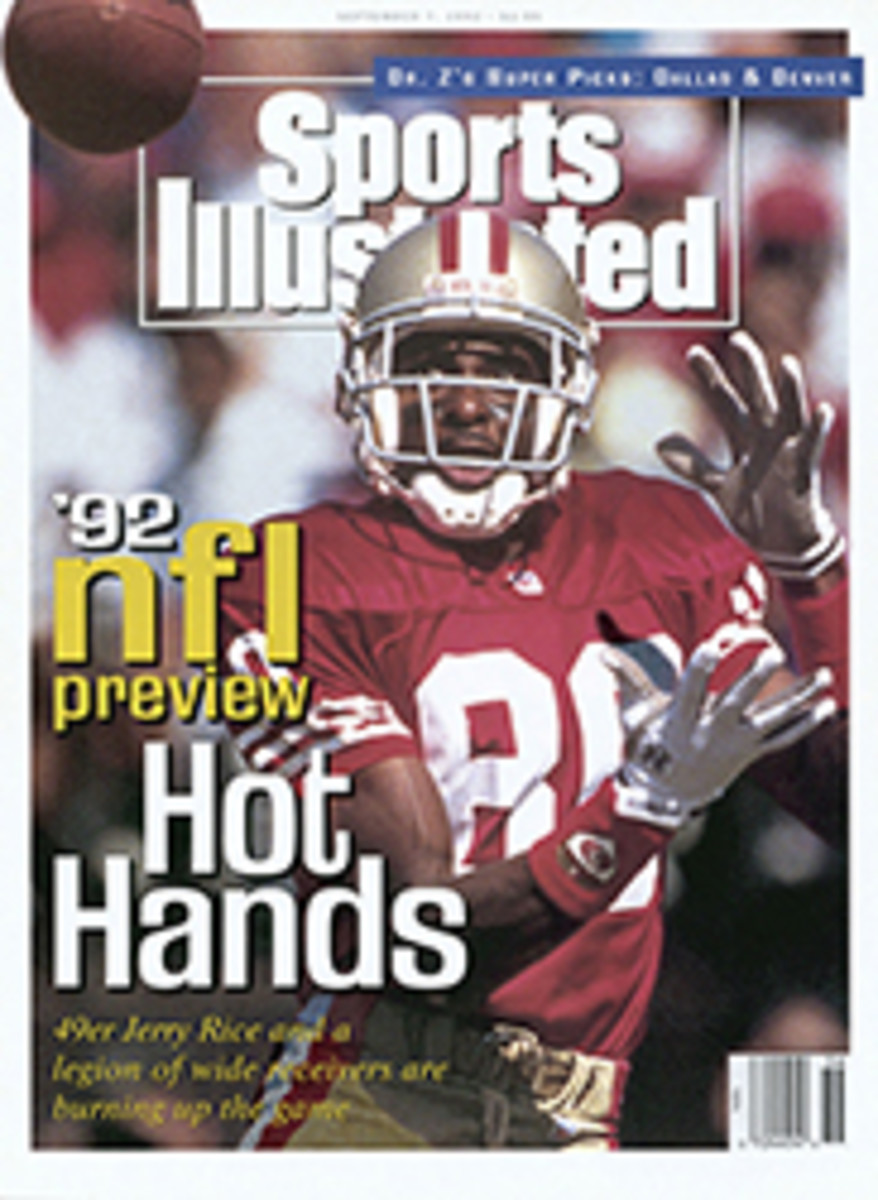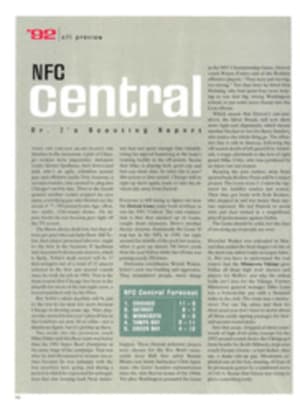
AFC east
Bikers and Philosophers, fun lovers and deep thinkers—the defense sets the tone for the New York Jets. In pass rushers Dennis Byrd, Jeff Lageman and Marvin Washington, weakside linebacker Mo Lewis and right cornerback James Hasty, who is ready to step into the ranks of the NFL's ultra-elite, there's a frenzied kind of talent at work. And all of it is brought to a high, overachieving level by coordinator Pete Carroll, 40, who's almost as free-spirited as the guys he coaches.
The Jets are a team of exceptional courage. Last season they bounced back from a heartbreaking Monday night loss in Chicago to crush Miami. The Jets had to beat the Dolphins again, in Miami, to reach the playoffs, and they did it by coming from behind and winning in overtime. So what's holding New York back?
Failure in the red zone, the goal-line neighborhood. Quarterback Ken O'Brien has been a sturdy warrior over the years, but he has taken too many hits. When the offense gets in close, he freezes. So the Jets devoted most of their training camp to the grooming of Browning Nagle, the team's second-round draft pick in '91.
The Jets made it easy for Nagle. They presented O'Brien with an insulting salary offer that they knew would keep him out of camp long enough for Nagle to gel plenty of snaps and game action with the varsity. Nagle responded with an up-and-down preseason; sometimes he was brilliant, sometimes he was disastrous. When the team and O'Brien agreed on a contract midway through the preseason, he reported to camp and stepped into a situation that was all but settled. Even after O'Brien looked impressive in the final two preseason games, Nagle was named the starter last Saturday.
Nagle is a pleasant, sleepy-eyed fellow with a fine arm, but how much inner fire he has is anybody's guess. If he comes through, then the Jets will be a serious Super Bowl contender. They can run the ball well enough, even though the coaches still haven't figured out that Freeman McNeil is the best back they have—Blair Thomas included. Al Toon and Rob Moore, a terrific set of wideouts, can make things happen downfield, and tight end Johnny Mitchell, this season's first-round draft pick, should be something special. New York could be the sleeper team of 1992.
What a shame that the Buffalo Bills picked Super Bowl '92 to come down with a case of the goofies. All that work, all that no-huddle magic, and then it blew up in a week and a game in which they appeared to lose their focus. Hardest hit was Thurman Thomas, a superb back who became the first player since Jim Brown to lead the NFL in combined rushing and receiving yardage for three straight years. His nobody-loves-me quotes, the lost helmet at the start of the Super Bowl—that's all behind him, he says.
The Broncos showed the world how to play defense against Buffalo: Collapse the pocket and send quarterback Jim Kelly scurrying around the perimeter. The Redskins cashed in on that strategy in Supe XXVI. Of course, having one of its sturdiest linemen, 310-pound guard John Davis, out and his replacement, Glenn Parker, hobbling on a bad knee didn't help Buffalo. Davis is still recovering from knee surgery. The offense, now minus its coordinator, Ted Marchibroda, who left to become coach of the Colts, will have more two-back sets this year and less no-huddle. Unpredictability is the phrase you heard around camp.
Defensive theory has changed too, the Bills say. No more running around blocks. Meet 'em head-on and play it tough, the way the Giants and the Eagles do it. We'll sec. With end Bruce Smith ailing last year, linebacker Cornelius Bennett did a heroic job of rushing the passer, but can he do it again? Smith is still rehabilitating his tender knee. This team has outstanding talent, but a lot of ifs.
Ever since the Miami Dolphins became a Dan Marino-led passing machine, they've been drafting for defense in trying to give some balance to the team. They have had a few successes—most notably linebacker John Offerdahl in '86, end Jeff Gross in '88 and safety Louis Oliver in '89—but only now have the Dolphins possibly found their impact guy, 259-pound pass-rushing linebacker Marco Coleman. A defense that has been in an eight-year slump could start showing signs of life.
Coleman, Miami's second first-round draft choice (the other, cornerback Troy Vincent, has been slow to develop), was a wrecker's ball in the preseason. And how important is a demon pass rusher? Just ask the Giants, whose whole tempo changed when Lawrence Taylor joined them in '81. Now the Dolphins, who have long been soft against the run, can crowd their linebackers and safeties in closer. Less time for the passer will make coverage assignments less nerve-racking. And better defense means better field position for Marino and the offense, which now includes former Denver blue-chip runner Bobby Humphrey.
Are we laying too much on a rookie? Probably, but this is an operation that desperately needs a shot of adrenaline. In the next few seasons Don Shula should pass George Halas as the winningest NFL coach of all time, but the Dolphins have missed the playoffs five of the last six seasons. They could see postseason action this year.
If front-office turmoil had a direct relationship to performance on the field, then the New England Patriots would be in a deep hole. The interim owner, James Orthwein, wants to sell the team or move it to St. Louis or something. The club's CEO, Sam Jankovich, has front-office personnel terrified of him. But what does this all mean when the Pats are digging in to stop an opponent on third-and-one and second-year coach Dick MacPherson—Coach Mac to his players—is running up and down the sideline, jacket Happing in the wind, screaming to hold them just this once? Or when the Pats need to drive the length of the field to get back in the game?
Coach Mac's enthusiasm was a burst of sunlight in '91, and New England responded by stealing a few games and winning some others on pure intensity. But how long does that last? Talent is thin. The defense is spirited but unsound. The offensive line is subpar, and tackle Pat Harlow's lingering back problem, combined with top draft choice Eugene Chung's slow start, doesn't help.
Laboring behind one of the worst offensive lines in recent memory, quarterback Jeff George of the Indianapolis Colts played at a high level in all 16 regular-season games last year. Then on Aug. 22 he went down with a stretched ligament in the thumb of his throwing hand in a preseason game against the Bengals, and hearts stopped until the news came that he was not lost for the season—but probably for the first two games. His injury, though, sent a grim reminder to the Colts: Get some protection for the franchise player before it's too late.
If you look at recent NFL disasters, teams that were supposed to be decent and then nose-dived (last year's 1-15 Colts certainly qualify), you'll usually find that one of two things caused the crash: a bad offensive line or no capable backup for an injured quarterback. Shortcomings such as these must be addressed.
Yet Indianapolis general manager Jim Irsay stuck to his premise that you win with defense, and he used the first two picks in the draft to take defensive tackle Steve Emtman, who was forceful in the preseason, and linebacker Quentin Coryatt, who was hampered by a bum ankle. Ordinarily those picks would make sense, but Indy shouldn't have shrugged off the miseries of its offensive line. Suddenly quarterback Jack Trudeau, who in 1989 was voted the team's MVP by his teammates and who was still a holdout when George went down, found himself bargaining for more than a backup's pay.
[originallink:10681366:711121]
PHOTO
RICK STEWART/ALLSPORT USA
The heart of the Jet defense is a pass rush led by free spirits such as Lageman (here sacking Packer Mike Tomczak).

